“Hey Zach, I’m worried my job history looks a little all over the place. How do I explain it without sounding like I can’t commit?”
That question came up in one of our Blueprint Q&A sessions—and I hear it all the time from engineering leaders with broad, non-linear career paths.
And it’s a fair concern—because let’s be honest, hiring managers will notice a résumé with a lot of short stints.
But here’s the good news: job-hopping isn’t a dealbreaker when you know how to tell the right story.
Let’s unpack how to reframe a varied background as a strategic advantage—and give you the confidence to walk into interviews with clarity, not anxiety.
#1 – Highlight Intentional Growth
Every job you’ve taken wasn’t random—it was strategic. Whether it was to level up your leadership chops, get exposure to a different industry, or learn how to navigate bigger orgs, you made those moves on purpose.
That’s exactly how I encourage the engineers I coach to frame it too. If your background looks broad, call that out confidently. Show how each step added a key skill or perspective that now makes you more valuable than ever.
“Each move helped me grow in a way I couldn’t have if I stayed in one lane. And now I’m ready to bring that full toolkit into a role where I can go deep and make a lasting impact.”
#2 – Show Your Adaptability
Here’s the truth: the best engineering leaders are learners. They can flex into new systems, new teams, and new challenges without breaking stride. That’s a superpower—not a red flag.
So when you’re talking about past roles, connect the dots for your interviewer.
“One of the benefits of my path is that I’ve had to learn fast, build trust in different cultures, and solve problems from multiple angles. It’s made me adaptable—and that’s something I bring to every team I lead.”
That’s what hiring leaders really want. Someone who can handle curveballs and still deliver.
#3 – Make It Relevant Right Now
You don’t want them guessing how your past applies to the job you’re interviewing for. Draw the line yourself.
“Working in both startup and enterprise environments gave me a unique blend of speed and structure. And I see that as a real fit here, especially with where your team is heading.”
This is especially important if your background spans different industries or roles. Help them see how it all connects to this opportunity, now.
#4 – Address the Pattern Head-On
If you’ve had a handful of roles in a short span, don’t dodge it—own it. But do it with clarity and confidence.
“I know it looks like I’ve made a few moves, and I get why that might raise a question. Each one was intentional, and I gained a lot. But I’m not looking for the next hop—I’m looking for the right place to plant my flag.”
This kind of direct, honest answer disarms the objection. And it gives you a chance to reinforce that your focus now is on depth, not just breadth.
#5 – Anchor It in Long-Term Vision
Once you’ve reframed the story, close with where you’re going. And be real about why this opportunity matters to you.
“What I’m after now is a role where I can truly grow roots—build something with staying power, develop people, and drive strategy. I’ve done the legwork… now I’m ready to go long.”
That shift in tone—from exploration to commitment—says a lot. It positions you as a leader who’s done the work to get clear and is now ready to deliver consistent impact.
Final Note
If your background looks more like a jungle gym than a ladder, don’t stress. That’s more common than you think—and it’s not a dealbreaker.
You just need to own your story, connect it to what matters most now, and speak with confidence about what you’re building next. That’s what great leaders do.
And if you need help crafting that story, let’s talk.
How many roles have you had in the last 10 years? Would you do anything differently?
Read you in the comments 👇



